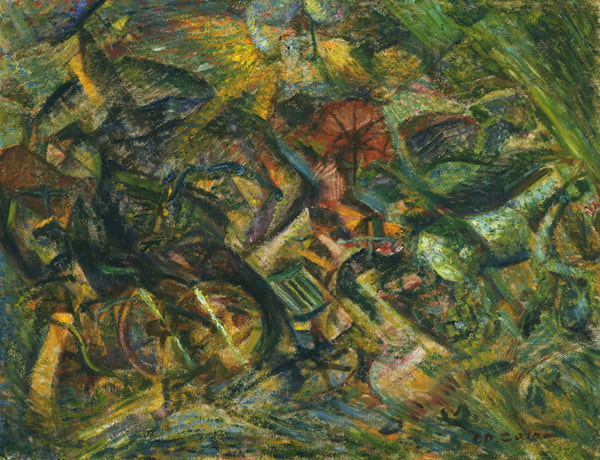Artist Birthday: Carlo Carrà
Carlo Carrà's work reflects the use of the Impressionist palette of pure colors by the Pointillists, while his segmenting of the subject to indicate movement reflects a similar aesthetic concern to both Futurism and Cubism. Carrà's fragmentation of space into intersecting Cubist planes creates a chaotic backdrop in which foreground and background intermingle. Most discernable are the wheels of the cab, and hints at light flowing from a street light.
Artist birthday for February 11th: Carlo Carrà (1881–1966, Italy)
Carlo Carrà was a leading artist of the Futurism movement in Italy.
 |
| Carlo Carrà, Jolts of a Cab, 1911. Oil on canvas, 20 ½" x 30" (52 x 76 cm). Courtesy of the Museum of Modern Art, New York. © 2025 Carlo Carrà / Artists Rights Society (ARS), New York. (MOMA-P2320crars) |
For the Futurists, driving an automobile epitomized their obsession with speed and technology. Marinetti's manifesto expressed the joy of driving recklessly into a ditch. In Carra's mind, the jolts of the cab links the driving of an automobile with the male personality in Italy leading up to World War I (1914–1918). The Futurists believed that how a man drove a car was a mark of his personal bravery, during a period when, in the West, women were lobbying for the vote and more women than ever had entered the work force.
The end of the 1800s was characterized by an overall skepticism about the rapid evolution of scientific discovery and industrialization in the West, because of the associated problems that came along with it: overcrowded cities, food shortages, poverty and crime. One result was art movements such as Symbolism, the Arts and Crafts movement, and Art Nouveau that looked to the art of the "good old days" (the Middle Ages and Renaissance) for inspiration.
Skepticism turned to optimism in the first two decades of the 1900s. For artists, originality, which had been valued in art since Romanticism evolved in the late 1700s, became an increasingly important aesthetic element for progressive artists in the first decades of the 1900s. His subjects, such as flying birds or moving planets, reflect a more lyrical approach to Futurism. At the same time, the obsession with speed and the fascination of the energy of modern life place his work firmly within the "laws" of Futurism.
In Italy, young intellectuals initiated a movement that would gradually encompass art called Futurism. The basic tenets of Futurism were the rejection of Italy's "stagnant" culture of the 1800s stuck in Neoclassicism and Renaissance ideals. Their revolutionary ideals were to smash the status quo completely and reenergize Italy through expanded industrialization in Italian cities and of Italian territory, and a rejection of any nostalgia and reverence for the past.
The Futurists saw war and the speed and dynamism of the machine as new standards of beauty. Extremely nationalistic, they advocated change, progress and the vitality of industry. These ideas were laid out in a manifesto by poet Filippo Marinetti (1876–1944) The Founding and Manifesto of Futurism in 1909-1910. Giacomo Balla, along with fellow artists Severini, Boccioni and Carra set forth the Futurist ideals for painting in Technical Manifesto for Futurist Painting (1910).
Carrà was a leading figure in the Futurist, and subsequent Metaphysical movements. He also wrote books about the nature of art. Carrà was born in Quargnento in the Piedmont. Attracted to art as a child, he left home at 12 to apprentice to a mural painter. In 1899, he was in Paris decorating the Italian pavilion for the 1900 Universal Exposition and became interested in the modernist experiments in French art at the time including Fauvism, and the Neo-Impressionist Pointillist style of Georges Seurat (1859–1895) and Paul Signac (1863–1935).
In 1906 he studied at the Brera Academy in Mila under the academic figurative/landscape painter Cesare Tallone (1853–1919). At this point his painting was a combination of lyrical Lombard naturalism, and Italian Pointillism, characterized by the "stitch" brush strokes pioneered by GIovanni Segantini (1858–1899), who adapted it from the small color square brush strokes of the French Pointillists. After co-founding the Futurist movement with Boccioni and others, Carrà went to Paris in 1911, where he was exposed to Cubism, the final influence on his mature Futurist style.
This image is in the following Davis program: Davis Collections: Pointillism

Comments